
 "Those who say much know nothing, Those who know much say nothing"
Lao Tze
"Those who say much know nothing, Those who know much say nothing"
Lao Tze
Following centuries of silence, there has been an upsurge of interest and a level of scientific research never before seen in relation to the ancient therapeutic treatment of acupuncture and moxibustion. It is a specialized field, possibly the most important aspect of traditional Chinese medicine not only because of its extensive applicability but also because of the great advantage offered due to the absence of undesirable side-effects. It is both a science and an art, and is characterized by its solid theoretical foundation (both deductive and empirical), by the various techniques for applying it and by its widespread clinical applications.
According to the theories which surround the creation of the universe, acupuncture and moxibustion are the strongest expression of traditional Chinese medicine. Acupuncture, a treatment which is becoming increasingly acceptable in the West, now plays a fundamental role in world allopathy in developed countries and, although there is still a long and difficult road to be travelled, the day of reckoning will soon arrive for all those who have cursed it and condemned it to obscurity as well as for those who have practised it conscientiously and competently.
After waiting for over eight thousand years, it is only on the eve of the 21 st century that the history of acupuncture is being given world-wide attention.
Countless numbers of research studies on traditional medical literature and archaeological finds have demonstrated that acupuncture therapy was already being used in primitive clan societies in the Stone Age. It seems that acupuncture was first discovered five or six thousand years B.C. while moxibustion first came into use with the discovery of fire.
Many history books discuss the legends linked to the origins of acupuncture and moxibustion. The most important of these are Diwang Shiji (The Centuries of the Emperors), Zhenjiu Jiayi Jing (A Classic of Acupuncture and Moxibustion) written during the 3rd century A.D.; Beiji Qianjin Yaofan (A Thousand Golden Remedies for Emergencies) and Xinxiao Beiji Qianjin Yaofan from the 7th and 11th centuries respectively and Lu Shi (History of the Meridians) from the 12th century. Names such as Fu Xi (the first Chinese agricultural specialist), Tai Hao (the leader of the famous Stone Age Yi tribe in Shantung Province who created the first bian stone) and Huang Di (the renowned Yellow Emperor) are frequently mentioned in connexion with the origins of acupuncture and moxibustion,
In early societies almost all tools were made of stone and, according to literature from the fifth century B.C. to the first century A.D., acupuncture needles were also fashioned from stone (bian, a stone suitable for making stone needles). In Zuozhuan (Commentary on the Annals of the Spring and Autumn Period, 550A.D.), Zang Sun wrote that "the suffering caused by an ailment is greater than the prick of a bian stone". In Shuowen Jeizi (Analytical Dictionary of Characters, 100A.D.) by Fu Wen/Xu Shen there is a reference to bian stones as extremely sharp pointed stones which were used to cure ("prick") disease. One of the masters of acupuncture, Quan Yuanqi (6th to 5th century B.C.), mentions the names given to the instruments used by his predecessors when classifying the different kinds of "needles": zhen shi (needling stone, bian shi (pricking stone), chan shi (piercing stone). We can thus assume that the history of acupuncture dates from the beginning of the Stone Age. Archaeological excavations carried out in Duolun in Inner Mongolia and Ri Zhao in Shantung Province show that bian stones date from that period.
Huangdi Neijing Suwen (The Yellow Emperor's Canon of Medicine) claims that acupuncture originated on the east coast of China in a region of fishermen during the early stages of primitive society while moxibustion originated in the North where the people lived from hunting and protected themselves with fire.
The Bronze Age began at around the same time as the introduction of slavery into China during the Xia, Shang, Western Zhou and Spring and Autumn periods (from the twenty first to the third centuries B.C.). At this point bian stones were gradually replaced with bronze bian. Recently uncovered objects such as shells and tortoiseshell dating from the thirteenth to the eighth centuries B.C. have hieroglyphic inscriptions concerning acupuncture treatments carried out with bronze needles and moxibustion therapy. Frequently mentioned are famous acupuncture doctors of the period such as Yi Huan, Yi He (sixth century B.C.) and Qing Yueren (fifth century B.C.), Zouzhuan written almost two and a half thousand years ago tells the story of Emperor Jing's (581B.C.) death after being treated by Yi Huan: "the illness had gone deep down into the gao huang ("vital ravine") and treatment by acupuncture and moxibustion was of no avail". It was also at around this time that the theories of yin and yang (the Taoist balance of opposites) and the Five Elements (Fire, Earth, Gold, Water, Wood) were introduced. Terms such as qi (vital energy), jing (meridians), shen (kidney), pangguang (bladder), xi (heart), fei (lung), etc., were also used in everyday medical circumstances. The study of "pulse" was increasingly gaining popularity and the theory of the environmental adaptation of the human body (the harmonious balance between Man and Nature) began to take shape.
Between the period of the Warring States and the Western Han Dynasty (475B.C. to 24A.D.), the feudal system became firmly rooted in China. During this period, the growth in the labour force and changes in the social system led to a deepening of medical and pharmacological knowledge. Knowledge developed from empiricism into theory and the increased use of metal needles contributed to a greater use of acupuncture.
In 1968, when a Western Han (113B.C.) tomb in Macheng in Hebei Province was being excavated, five silver and four gold needles were found giving a good idea of the shape and size of needles which were in use at that time.
Huangdi Neijing Suwen (The Yellow Emperor's Canon of Medicine), written over two thousand, four hundred years ago in the form of a dialogue between Emperor Huang Di (one of the three great legendary emperors of China, the other two being Fu Xi and Shan Nang) and his prime minister Chi Po, became a reference point in the history of Chinese civilization and is now considered to be the greatest historical treaty on medicine ever produced. It consists of two volumes, Questions and Answers and Canon of Acupuncture, and explains the theory of yin and yang, the Five Elements, zang fu (hollow and solid viscera), jingluo (meridians and collaterals), Mind and Spirit, qi (vital energy), Blood and Body Fluids, the Five Emotions, etc., and describes acupuncture and moxibustion as being the principal techniques for therapy, During the same period, Shi Yi (Historical Annals), Huangdi Bashiyi Nanjing (Imperial Canon on Eighty One Difficulties) and Mingtang Kongxue Zhenjiu Zhiliao (Essential Acupuncture and Moxibustion Points) were also written but they have been lost.
From the Eastern Han Dynasty (265B.C.) to the period of the Warring States, all knowledge on traditional Chinese medicine was summarized and compiled. Hwa Tuo, a specialist on the "phenomenon of the propagation of stimuli along acupuncture meridians" and author of Zhenzhong Jiuci Jing, discovered a great number of points (now called huatuo jiaji) and was a pioneer in the field of anaesthesia using acupuncture in conjunction with medicinal herbs. Zhang Zhongjing, another famous doctor of the same period, wrote Shanghan Zabing Lun (Remedies for Feverish Complaints caused by the Cold) in which he described different techniques for applying acupuncture and moxibustion and various kinds of treatments using medicinal herbs.
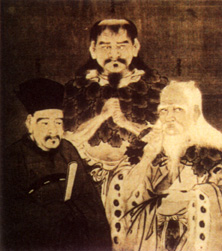 The three legendary emperors: Fu Xi, Shan Nang and Huang Di (a fresco from the 18th century I798)
The three legendary emperors: Fu Xi, Shan Nang and Huang Di (a fresco from the 18th century I798)
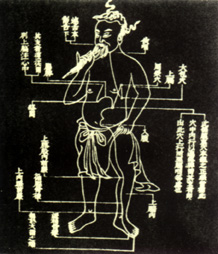 The jingluo (meridians and their collaterals), Yizong Jinjian Cijiu Xinfa Yaojue (Acupuncture, the Golden Mirror of Medicine), 1739 - 1742
The jingluo (meridians and their collaterals), Yizong Jinjian Cijiu Xinfa Yaojue (Acupuncture, the Golden Mirror of Medicine), 1739 - 1742
During the Jin and Northern and Southern Dynasties (265-581A.D.), at a time when the country was being ravaged by wars and political and economic chaos, there was continued development in the field of acupuncture both in its use as a treament for various illnesses and in the publication of countless works of both original and compiled material. Various compendia and diagrams were published including Yance Tu (decumbent lateral view) and Mingtang Tu (a catalogue of acupuncture points and meridians). Between 256A.D. and 260A.D., the famous doctor Huangfu Mi produced Zhenjiu Dacheng (A Classic of Acupuncture and Moxibustion), a twelve-volume work composed of excerpts from books previously published such as Huangdi Neijing Suwen (The Yellow Emperor's Canon of Medicine) and Mingtang Kongxue Zhenjiu Zhiyao (Essential Acupuncture and Moxibustion Points), a book which described over three hundred acupuncture points.
The feudal system operated under the Sui and the Tang Dynasties (581-907A.D,) was a period of economic and cultural prosperity in China, In 627-649A.D. the Tang government ordered Zhen Quan to revise all the great treatises on acupuncture which existed at that time and bring them up to date, In the two years between 650 and 652, Sun Simiao compiled Beiji Qianjin Yaofan (A Thousand Golden Remedies for Emergencies), then Qianjin Yifan (A Thousand Supplementary Remedies for Emergencies) in 680 and, in 682-685, Mintang Sanren Tu (Diagram of Three Figures) showing the twelve main meridians, the eight secondary meridians and almost six hundred and fifty acupuncture points. Other works also appeared at this time which made a contribution to the field. For instance, Guzhengbing Yinfang (Moxibustion in Fatal Illnesses) written by Cui Zhiti during the Tang Dynasty, discussed tuberculosis of the lung and how to treat it. Xinki Beiji Jinjing (New Moxibustion Remedies for Emergencies), written in 862A.D., was the first book in the history of mankind to be printed. Another development in the Tang Dynasty was the establishment of the Imperial Medical College which had four specialized medical departments, one pharmacology department and one acupuncture and moxibustion department which had a staff of one acupuncturist, ten instructors, twenty assistants and twenty pupils.
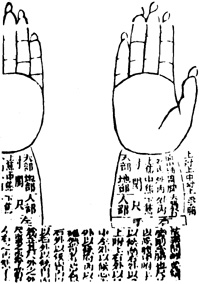 The different kinds of "pulse" (a diagram from the 3rd century).
The different kinds of "pulse" (a diagram from the 3rd century).
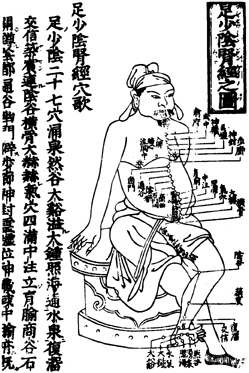 Diagram of the Shaoyin meridian showing the twenty seven acupuncture points which go from the feet to act on the kidneys.
Diagram of the Shaoyin meridian showing the twenty seven acupuncture points which go from the feet to act on the kidneys.
During the Five Dynasties and the Song, Jin and Yuan Dynasties (907-1368A.D.), printing became popular and allowed traditional medicine techniques to spread and be developed all over China. Supported by the Northern Song government, the celebrated acupuncturist Wuang Weiyi was able to revise all the acupuncture points on the principal meridians and their relationship with the zang (solid viscera) and fu (hollow viscera). By 1026 he had published the Illustrated Manual on the Points for Acupuncture and Moxibustion and in 1027 he ordered two life-size bronze models to be cast (still preserved today in the musuems at Beijing and Nanjing) showing the internal relation between the different organs and the distribution of acupuncture points and meridians. In 1341, in the Yuan Dynasty, Hwa Shou devoted himself to countless studies on acupuncture points and meridians and published the results of his research in Shisi Jing Fahui (An Exposition of the Fourteen Meridians) which was the forerunner of the present Theory on the Main Meridians and their Collaterals.
As a result of the progress which was made, acupuncture was beginning to be divided into smaller areas and, as early as this stage, there were several doctors who worked in specialized fields. Countless valuable works were published such as Xiaoer Mintang Zhengjinjing (A Treaty on Paediatric Acupuncture and Moxibustion), Jongju Shenmi Jinjing (Secret Remedies for Abcesses and Ulcers), Beiji Jiufa (Moxibustion in Medical Emergencies), etc., and several different kinds of applications were spread both as therapeutic methods and for use as an anaesthetic before and during operations.
It was in the Ming Dynasty, however, that acupuncture reached its peak as the principal medical treatment throughout China. Names such as Chen Hui, Ling Yin and Yang Jizhou played a fundamental role in bringing all of the knowledge which had been gathered up to that point into common practice. They also had a huge influence in spreading acupuncture techniques through Europe and particularly France. The most varied and complete studies on the field data from this period and some of these historic works are still consulted to this day. Among them are Puji Fang (Universal Cure), (Shenjiu Men (The Door to Acupuncture and Moxibustion) both written in 1406, Zhenjiu Daquan (Complete Works on Acupuncture and Moxibustion) written by Xu Feng in the 15th century, Zhenjiu Juying Fahui (A Summary of Writings on Acupuncture and Moxibustion) written by Gao Wu in 1529, Zhenjiu Dacheng (Compendium of Acupuncture and Moxibustion) printed in 1601 based on work done by Yang Jizhou from the Jin Dynasty, Zhenfang Liuji (Six Volumes of Acupuncture Remedies) written by Wu Ku in 1618 and so the list goes on. There were also developments in comparative studies on the technical differences between acupuncture and moxibustion and their results as is the case of Zhenjiu Wendui (Questions and Answers about Acupuncture and Moxibustion) written in 1530 by Wang Ji and, finally, new acupuncture points were discovered.
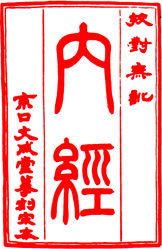
The cover of Huangdi Neljing Suwen (The Yellow Emperor's Canon of Medicine), (475-221 B.C.)
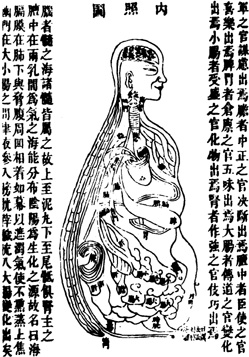
A diagram of the five viscera from
Recueil de Traités Taoistes, 1615, held in the
National Library in Paris.
The arrival of the Qing Dynasty in 1644 brought with it a decline in the use of this ancient treatment. Acupuncture was increasingly replaced with "young" western medicine and traditional Chinese medicine, in particular acupuncture, entered a period of prohibition which was to last for around three centuries. With its history of one thousand, two hundred years, the Imperial Medical College, founded in the Tang Dynasty, was closed. All the same, some works were still published and, thanks to some pockets of conservative resistance, the art of acupuncture was not completely forgotten, In 1742, Wu Qian wrote Yizong Jinjian Cijiu Xinfa Yaojue (Acupuncture, the Golden Mirror of Medicine) while in 1817, Li Xuechuan published Zhenjiu Fergyuan (The Origins of Acupuncture and Moxibustion).
Following the start of the Opium War (1840), China became a semi-feudal and semi-colonial society and it was at this time that western medicine was imposed and "legalized". What should have been a gentle evolution became, in actual fact, yet another of the aggressions perpetrated by the Qing government against the Chinese population. Acupuncture was used only as an instrument of torture and the needles were described as "needles of death".
In 1912 the Republic of China was declared and acupuncture remained in a state of stagnation. It was used only in the rural areas as a "popular medicine" far from the realm of those who were in power. The early anti-government movements heralded a new era for this ancient therapy. At first it was used by the young Chinese Communist Party during the revolution but gradually it came back into use in all the liberated zones.
In 1944, many western doctors who supported the young revolutionaries started to study acupuncture following a speech given by Mao Zedong on "the workers' united front", in ShanxiKansu-Ningxia. These doctors covered many areas of research. In April, 1945, the first "New Era" acupuncture clinic was opened in the International Peace Hospital in Yunnan Province. It was called the Dr. Norman Bethuman Clinic. In 1947, the Practical Guide to Acupuncture and Moxibustion was published in Jinan and, in 1948, the first course in acupuncture to be financed by the Ministry of Health of the People's Government of Northern China was established. Just as a seed is sown, all of these small moves forward contributed to the techniques of acupuncture and moxibustion being disseminated, promoted and better understood.
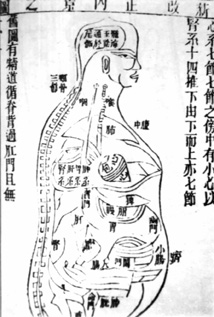
"Zang-fu" (solid and hollow viscera) in Yance Tu (decumbent lateral view), 4th century A.D.
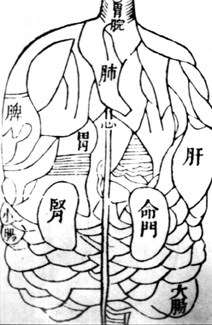
Relative space between the hollow and solid viscera in Qianjin Yifan Lingshu Suwen (A Thousand Supplementary Remedies for Emergencies), 7th century A.D.
Following the Liberation of the People and the founding of the People's Republic of China, one of the mottoes of the new government was "to unite western and traditional Chinese medicine" As a result of this, acupuncture and moxibustion enjoyed unprecedented popularity and promotion as from October, 1949. In 1951, the Experimental Clinic for Acupuncture and Moxibustion, later called the Institute of Acupuncture and Moxibustion, was founded and, in 1955, the Academy of Traditional Chinese Medicine was founded.
During the fifties, countless numbers of institutions and organizations were created throughout China at municipal, provincial and regional level. They concentrated most of all on researching traditional pharmacopoeia and medicines and specialized departments of therapy using acupuncture were established both in the communes and the major urban centres.
There have been three stages in the evolution of "New Era Acupuncture" from its beginnings to the present day. During the fifties, basic theories of acupuncture and moxibustion were systematized, their clinical applications were studied and opinions on "historical acupuncture" were brought up to date. During the sixties, there was major revision of the great canons and they were summarized. The various therapeutic effects in different pathologies were studied and compared and anaesthesia using acupuncture became common. In addition to this, there was much research on how acupuncture affected the different viscera and organs of the human body. From the seventies, the use of acupuncture as an analgesic and anaesthetic was studied in depth and innumerable discoveries have been made in the fields of surgery, anaesthesiology, neuroatomy, the physiology of analgesia, biochemistry and so the list continues.
It could be said that acupuncture has entered a fourth stage of development. Scientists and researchers all over the world are concentrating their efforts on studying the "phenomenon of the propagation of stimuli along the meridians", something which was first discussed by Hwa Tuo over two thousand years ago, although not dismissing the ancient beliefs which are still relevant to this day Even though it may be impossible to completely replace the unique "treatment with needles", there have recently been many attempts at exploring therapies using lasers, microwaves and infra-red light.
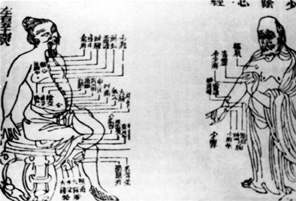
On the left, dachang (the large intestine), Shou Yangming Jingluo (the Yang meridian of the "solar light" of the upper regions); on the right, wei (the stomach), Zhu Yangming Jingluo (the Yang meridian of the "solar light" of the lower regions)
In Qianjin Yifan Lingshu Suwen (A Thousand Supplementary Remedies for Emergencies), 7th century A.D.
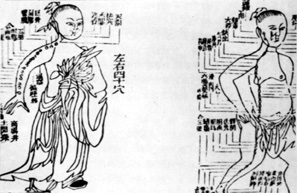
On the left, shen (the kidney), Shou Shaoyin Jingluo (the lesser Yin meridian of the lower regions); on the right, xin (the heart), Zu Shaoyin Jingluo (the lesser Yin meridian of the upper regions).
In Qianjin Yifan lingshu Suwen (A Thousand Supplementary Remedies for Emergencies).7th century A.D.
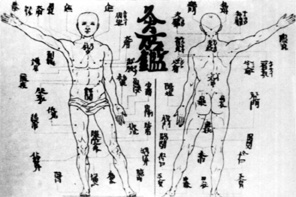
Moxibustion points (French engraving from the 18th century),
Acupuncture was introduced into Korea in the sixth century A.D. when several acupuncturists were sent to Baiji during the reign of Emperor Liangwu. By 693 A.D. the first Professor of Acupuncture was appointed. Acupuncture and moxibustion were introduced into Japan during the Jin Dynasty and the Chinese government presented the Mikado with a copy of the Great Treaty on Acupuncture in 552 A.D.. Throughout the seventh century, the Japanese government sent many doctors to China in order to attain the objective specified in a decree from 702 A.D. that Chinese medicine of the Tang Dynasty should be imitated. After this point, "kampo" (the study of acupuncture) was a compulsory subject in all the medical schools of the country.
The cultural exchange between China and the rest of the Southeast Asian countries led to the dissemination of acupuncture throughout the continent. During the Ming Dynasty, in the fifteenth century, acupuncture was introduced into Europe, and France played an important role in its subsequent dissemination throughout the world.
After the founding of the People's Republic of China in October, 1949, and in accordance with all the Sino-Soviet treaties of cooperation, acupuncture was introduced into all communist countries. In a move generated by Mao Zedong and Hwa Ko Feng, acupuncture once more regained the dignity it deserved and now the Institutes of Acupuncture in Beijing, Nanjing and Shanghai are the main educational institutions in the field of acupuncture in the whole world. In 1975, at the request of the WHO (World Health Organization), courses in acupuncture and moxibustion to be given in Chinese, Japanese, Spanish, French and English were set up with the hope of achieving that organization's motto "health for all by the year 2000" and up till now around six thousand doctors from over one hundred countries have been trained. In 1979, the Chinese Acupuncture and Moxibustion Association was founded.
In May, 1985, the International Association of Acupuncturists was founded in Gothenburg (Switzerland) with doctors from around fifty different countries including Portugal (Macau) and in November, 1987, the World Federation of Acupuncture Societies was established thus reflecting the interest which the rest of the world is showing in this ancient Chinese therapy.

Bronze statuette from the 12th century. Acupuncture was being practised over fifteen centuries ago. The holes show the main puncture points for obtaining a balance in the patient's pneuma. It is interesting to note the hermaphrodite anthromorphology of the figure. (Museum of Mankind, Paris)
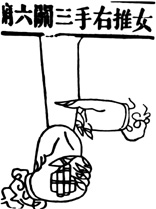
Feeling the pulse on the right hand (female) Xiaoer Mintang Zhenjinjing (Treatise on Acupuncture and Pediatric Moxibustion), XIVth century.
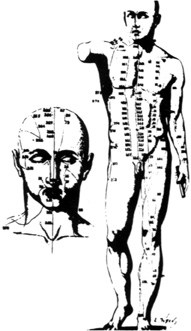
Diagram showing acupuncture points (Paris, 1863)
*MD (Portugal); PhD (Sri-Lanka); D. Ac. (China); FPAIA (Switzerland); at present employed as an acupuncturist in the Conde S. Januário Hospital in Macau.
start p. 47
end p.